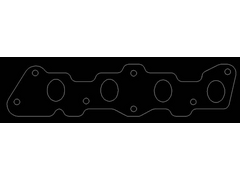andyharding
|
| posted on 2/6/06 at 07:02 PM |

|
|
AutoCad
Being an AutoCad noobie what's the best way to get a pattern i.e. inlet manifold gasket into AutoCad to generate a dxf or dwg file to supply to
a waterjet cutter?
Coming soon:- waterjet cut bike carb / throttle body manifolds 
Are you a Mac user or a retard?
|
|
|
|
|
Guinness
|
| posted on 2/6/06 at 07:08 PM |

|
|
er, if you mean you want to import it, then i don't think you can.
you'll have to measure it, pretty carefully and draw it up. i have my works laptop at home this weekend so could cad it up pretty quick if you
wanted.
Mike
|
|
|
andyharding
|
| posted on 2/6/06 at 07:10 PM |

|
|
Yeah I figured I'd have to draw it but wasn't sure the best way.
Was thinking drawing round the gasket onto 2mm graph paper and then using that to measure from.
Does this sound like the right way to go about it?
Are you a Mac user or a retard?
|
|
|
Guinness
|
| posted on 2/6/06 at 07:13 PM |

|
|
yeah, but remember that cad is mainly co-ordinate driven, so pick one point, usually bottom left and measure right and up from there to each corner,
centre of circles etc,
that should work, but i'm already on the stella so will retire back to the shed and finish taking my engine out!
|
|
|
Aboardman
|
| posted on 2/6/06 at 07:24 PM |

|
|
can you cannot just send them the gasket and ask for a copy in 4mm steel or what ever thickness you need.
|
|
|
Liam
|
| posted on 2/6/06 at 07:27 PM |

|
|
I've done things like this before pretty successfully just carefully measuring up with verniers. You often find manufacturers have chosen nice
round numbers (at least to 1mm) for things like port spacing, bolt hole centres etc etc.
Make sure your printer is calibrated properly in autocad so that you can print out your drawing the correct size and compare it against the real
thing.
One approach I have taken before is to scan a part (your gasket would work well), then import the photo to autocad and draw over it. You then need to
scale it to the correct size against some reference and again check against the real part with a calibrated printer. This is useful for complicated
shapes (around the edge of the gasket for example). Simple things like rows of port holes may be better just measured.
Liam
|
|
|
rusty nuts
|
| posted on 2/6/06 at 07:41 PM |

|
|
Can't help with the Autocad but do you have any prices yet for the manifold? Was about to start making one for my crossflow tomorrow.
|
|
|
andyharding
|
| posted on 2/6/06 at 07:56 PM |

|
|
Haven't thought about prices yet.
Suggestions welcome though...
Are you a Mac user or a retard?
|
|
|
andyharding
|
| posted on 2/6/06 at 07:56 PM |

|
|
quote:
Originally posted by Aboardman
can you cannot just send them the gasket and ask for a copy in 4mm steel or what ever thickness you need.
Yes but it's a *lot* cheaper if I can just send them the file.
Are you a Mac user or a retard?
|
|
|
Mansfield
|
| posted on 2/6/06 at 08:32 PM |

|
|
One of the best ways of doing this in AutoCAD is to scan the pattern you require with two known good scales (placed on the scanner as an X-Y axis,
steel rules usually) at the same time.
Import this scan into AutoCAD and scale up the image using the known distances from the scales (in X and Y, just in case your scan as affected the
aspect ratio).
After that 'trace' the image using ONLY straight lines and regular arcs. Set your layer colour for the trace to green or red so you can
see it against the black and white.
When you are happy with this, print it out 1:1, and check your pattern meets the plot. Draw in mm, your waterjet cutter will be most happy with
this.
If you only have an A4 scanner this can be done in two halves - it just requires a bit more care, and maybe an overall datum length (like ports 1 to 4
pitch) to make sure you have it correct.
I cant help you with the scan, but if you sent me the scans I could sort out the CAD and send you a 1:1 plot so you could make sure the CAD was
good.
No cost to you, if you want some help.
David.
|
|
|
andyharding
|
| posted on 2/6/06 at 10:42 PM |

|
|
That was painless:-
 
CVH Inlet
Thanks for the help!!!
Are you a Mac user or a retard?
|
|
|













